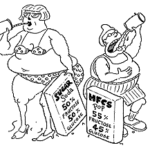By Ben Fuchs | Pharmacist Ben
The average American consumes 55 pounds of high-fructose corn syrup each year topping a list of 42 countries according to a paper published in the journal Global Public Health. Second highest consumption according to the report occurs in Hungary (46 pounds) fructose, followed by Slovakia, Canada and Bulgaria. And, according to the article, the countries with the highest consumption suffered significantly increased prevalence for diabetes independent of ordinary sugar intake and diabetes. And, the health disaster monster that the large intake of high fructose corn syrup represents has long tentacles that ultimately affect every system of the body.
 One example involves fructose’s relationship with the amino acid tryptophan. Fructose can complex with the important mood enhancing amino acid tryptophan. This makes tryptophan unavailable to the brain when that happens BIG trouble can follow! Tryptophan is mega-mega important for mood and wellbeing. It gets turned into melatonin and serotonin which are arguably the two most important chemicals in the brain. You can think of tryptophan as natural Prozac and for many people fructose will be blocking it from access to the brain.
One example involves fructose’s relationship with the amino acid tryptophan. Fructose can complex with the important mood enhancing amino acid tryptophan. This makes tryptophan unavailable to the brain when that happens BIG trouble can follow! Tryptophan is mega-mega important for mood and wellbeing. It gets turned into melatonin and serotonin which are arguably the two most important chemicals in the brain. You can think of tryptophan as natural Prozac and for many people fructose will be blocking it from access to the brain.
Here’s where it gets really interesting from a biochemical perspective. The brain has an appetite area, that initiates hunger sensations and a satisfaction area that shuts these sensations down. And it uses tryptophan to determine which center will be activated. All day long it is scanning the blood for this important amino acid. When tryptophan levels rise, activity in the satisfaction center is turned on and hunger ceases. Low tryptophan levels on the hand stimulate brain activity in the appetite or hunger center. If fructose is complexing with tryptophan, preventing it from getting into the brain it will take ingestion of a lot of tryptophan for the brain to to activate satisfaction centers vs. the “go get us a Coke or an ingestion apple or some other kind of sugar” center.
If you find yourself unable to stop eating AND you’re ingesting lots of high fructose corn syrup, or table sugar, which is 50 percent fructose, you may want to try switching sweeteners. Especially if you are dealing with diarrhea, loose stools, gas cramping or bloating after ingesting processed foods, fruits or fruit juices. Stevia and xylitol are probably the best choices you can make, and I like to use coconut water which a bit expensive, but can provides electrolytes and vitamins not available in other sweeteners. And it probably wouldn’t hurt to add a little daily supplemental tryptophan to your supplement program. You can use 200mg of 5HTP daily or 500-1000 mg of tryptophan. Take it at bedtime, though, it may make you drowsy.
Article cited:
Goran, M., Ulijaszek, S. and Ventura, E. (2012). High fructose corn syrup and diabetes prevalence: A global perspective. Global Public Health. Published online Nov. 27, 2012.














